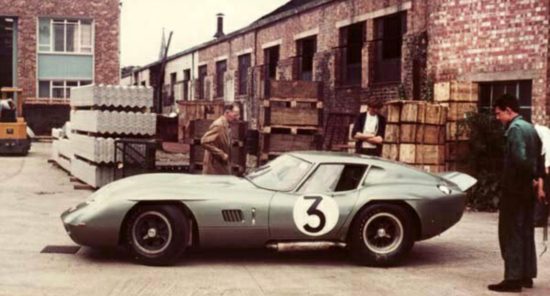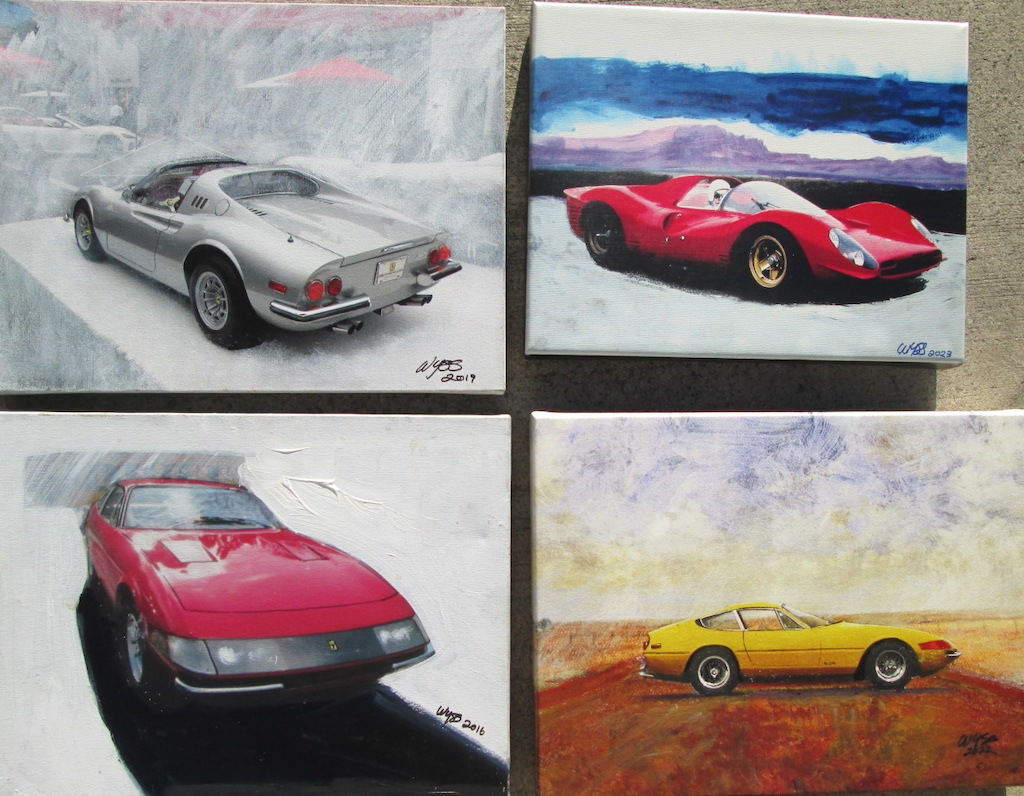by Wallace Wyss –
Sometimes you link up with a customer and make something for him and damn if the car you made for him doesn’t become more known than your own.
That’s what happened to AC cars, a very old automaker in England, one founded by the Weller Brothers in 1903, originally selling cars under the Weller name. But a butcher who was an investor wanted a delivery vehicle and that became popular among shop owners. It was called the Auto Carrier and soon the company became AC Cars Ltd.
Sports car driving was just starting then and they introduced the AC Ten, a small sporty two-seater. But the outbreak of WWI put a kibosh on that. But at least the AC Ten was the company’s first four wheeled vehicle.
After the war they began making a six cylinder engine, and the cars they built with that engine began winning. In 1930, they were bought out by the Hurlock family, who ran a transport business.
Another war and they were back on the market in ’47 with a sports car. Then serendipity—they saw a one off sports car made by John Trojiero, and decided to buy rights to it, paying him a pittance royalty on each car built. That car was more or less a copy of the Ferrari 166 Barchetta, and was offered by Tojiero with various engines. AC sold it as the AC Ace.
Good looking car but the engine created by John Weller back in 1919 was a loser. They started buying engines from Bristol, also a car maker and those were brisk racers but when Bristol decided to drop the six (theirs was actually a prewar German design) a dealer named Ken Rudd made do with modified Ford straight sixes.
ALONG COMES A COWPOKE
About that time, Carroll Shelby, known far and wide as the winning driver (along with Roy Salvadori) for Aston Martin at Le Mans in ’59, came along and said he had an engine, a ironblock 289, which he wanted to put in their car to replace the Bristol six. AC was a bit desperate because the inline Ford engine was not maximizing the car’s potential. And they figured Shelby was a rich guy on a roll.
AC didn’t know that Shelby had already been turned down by Healey. Only that time he wanted to put Chevrolets in Healeys. Donald Healey told him the car was doing just fine. So Shelby went to Ford and the rest is history. The first Cobra was made in Dean Moon’s Santa Fe workshop in 1962.
Shelby jammed into the Ace 3.6 prototype, chassis CSX2000 the 221 cid V8. By the time he got the car to America the Ford people sent him a 260 cid version. The first run of over 100-plus Cobras had that one and then he went with the larger 289 cubic inches (4.7L)
When the Cobras first got out there, it was obvious they couldn’t catch the Ferraris. The top speed was around 165 with a fastback hardtop. But Ferrari had the coupe called the GTO but even with a 3 liter engine it could outrun the Cobra. Ford tried to buy Ferrari but after first talking to him, Ferrari walked. Henry Ford II, in revenge, vowed to show the world Ford could beat Ferraris.
So he bankrolled Shelby’s Cobras. But only because Ford didn’t have a Ferrari beater built yet. They were working on it but it wouldn’t get done until 1964.
SHELBY BACKS AN AERODYNAMIC COUPE
But the Cobras were badly designed aerodynamically. Along came a temporary solution, the Daytona coupe designed by Shelby’s former driving teacher in his racing school, Pete Brock, who had interned at GM Styling. This car bought Ford some time while they developed a 200-mph race car, the GT40.
Now back at AC they weren’t just observing this without taking it as an insult. Why hadn’t Shelby asked them to do a coupe. So their own designer, AC designer Alan Turner came up with an alloy bodied coupe that was equally capable of beating the Ferrari GTO, and had a similar Kamm effect tail (chopped off tail, as per the dictates of Dr. Wunibald Kamm, a prewar German scientist).
There was a little bit borrowed from other cars, the front fenders Ferrari like, the Mercedes 300SL like strakes over the wheel wells but under the body it was much like Shelby’s Cobra 289. The gearbox was still a Borg Warner T-10 four speed manual transmission. It was more aerodynamic than Brock’s design.
But the Daytona was 37 lbs. lighter than the British car at 2440 lbs. Plus AC wanted longevity so they didn’t tweak the engine as much as Shelby, who squeezed 390 hp. out of the 289. Shelby didn’t really pay much attention to longevity, as a result got, 45 more horsepower than the A98 which is what AC called their car. AC took their car out for testing at Le Mans unpainted in April 1964. But the car had front end lift and couldn’t do more than 161 mph which was what a roadster could do.
They were a minute slower than the American car per lap. Once they got it back to the factory, they added a rear spoiler and a large hole in the bonnet to suck air out of the radiator.
They were running out of time to test it and snuck out on the new M1 motorway at 4:30 am and ran 185 miles per hour (297 kph). But word spread and they got into trouble and the government passed a speed limit on the new freeway.
Once they got to Le Mans they could do a lap in 3:58, a mere 2.1 seconds behind the fastest Shelby Daytona driven by Dan Gurney and Bob Bondurant. They qualified second in GT and 13th overall but more important all the Cobra coupes qualified better than the Ferrari 250 GTO.
In the race the AC was soon leading the prototypes at 119 mph. But a few hours later, when it returned with a fuel pick up problem. They found debris in the fuel filter. The debris turned out to be newspaper clippings—sabotage! (NOTE: In the movie Ford v Ferrari, they hint at sabotage, and it was a factor at Le Mans…)
The car ran good with the new filter but at 125 mph two hours later it blew a tire, flipped and was struck by Ferrari driver Giancarlo Baghetti in his 275P, who rammed it over the crash barriers. The driver was able to walk from the car but Baghetti, unhurt himself, had struck three lads who had snuck into a restricted area and were killed when the cars came ramming through.
The AC coupe was so destroyed that there was no thought of rebuilding it. It went back to the works and was covered by a tarp.
It wasn’t until 1972 that veteran AC racer Barrie Bird talked them into selling it. The original body bucks were still around so a new body was made. There was a metal shop, that of Maurice Gomm, and he was able to duplicate it. It was a long restoration, twelve years, finished in 1984.
The restored car raced at the Le Mans Legend revival event in 1998 and later was displayed at Goodwood. And so it was, AC’s own response to Shelby’s Daytona coulda been a contender, except for that flat tire.
Let us know what you think in the Comments.
THE AUTHOR: Wallace Wyss is the author of three books on Shelby, the latest of which is SHELBY The Man, the Cars the Legend.









The “prewar German design” straight six engine was a BMW design taken by the British as war reparations.
A beautiful and unique coupe by AC. Too bad for the crash otherwise it could have had a successful racing history. I have seen a number of photos and video of the rebuilt A98 coupe in use in present day. The photo above with the unpainted coupe I believe is not the actual car but someone’s reproduction of the A98. I believe this “tribute” car may be either in Australia or in South Africa
I suspected it didn’t look the same.I’d have to figure out if the Mustangs in the background are RHD or LHD to hazard a guess where it was taken.
How interesting.
And in the exact same era, the Maserati Tipo 151 was built to do the same job, and probably similarly, was an under-developed car for the Le Mans rigours.
If the AC98, or the Maserati 151s had been better prepared and developed, what would have come of the Ford vs Ferrari battle.
The last iteration of the 151 by Drogo is similar to the AC 98 and Daytona, but was faster than the GT40s in 64.
What could have been.
Anthony,
What is the status of your Maserati Tipo 151? Is that it in the attached photo?
Hi Mike.
No, mine is still in progress, but hope to have it road registered and track ready by end October.
The one pictured is the Barrie Baxter car in the UK, originally the car from the Klaus Collection in Switzerland.
Mine will be the same iteration (the ’64/’65 Tipo 151-004 car)